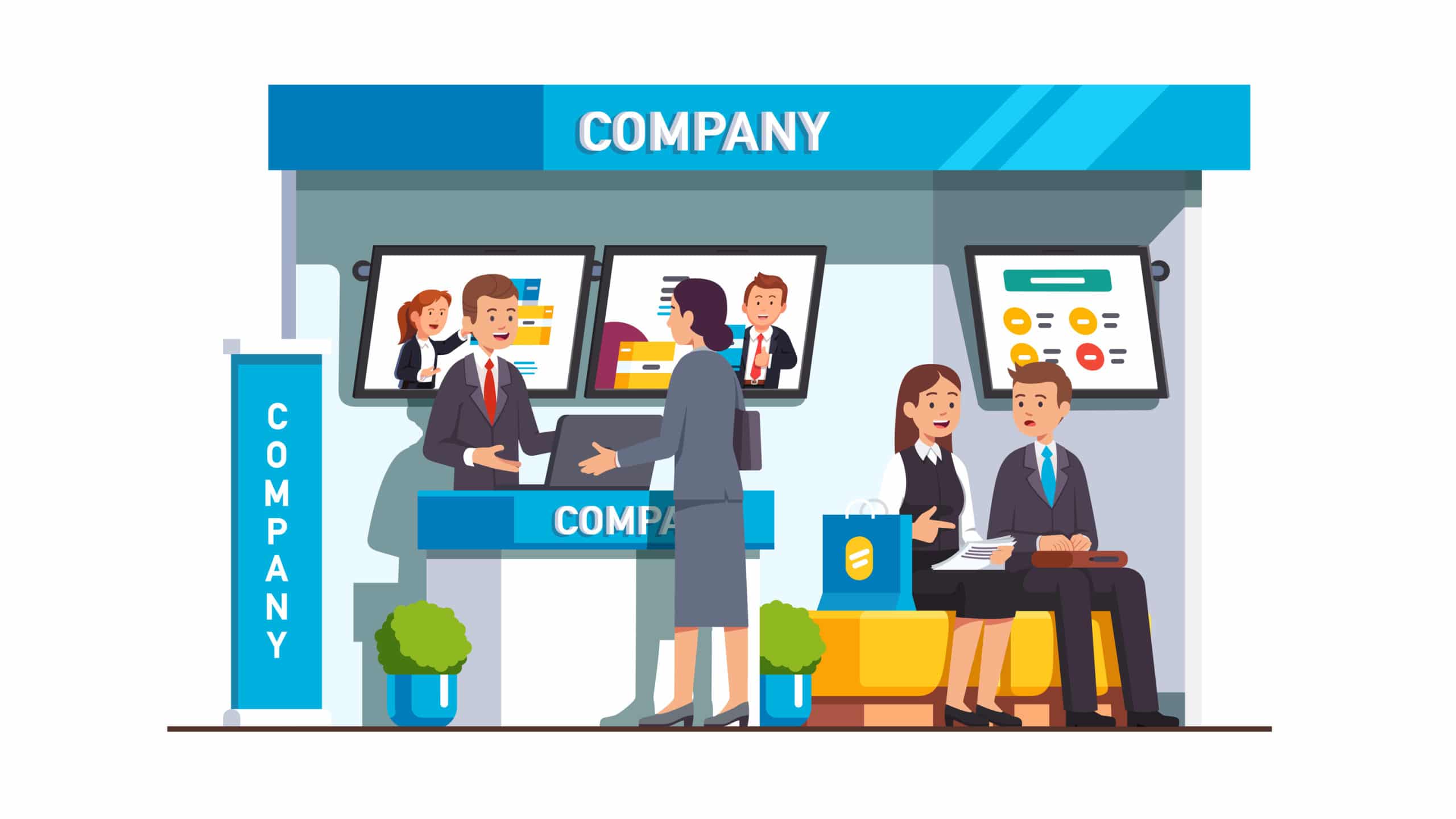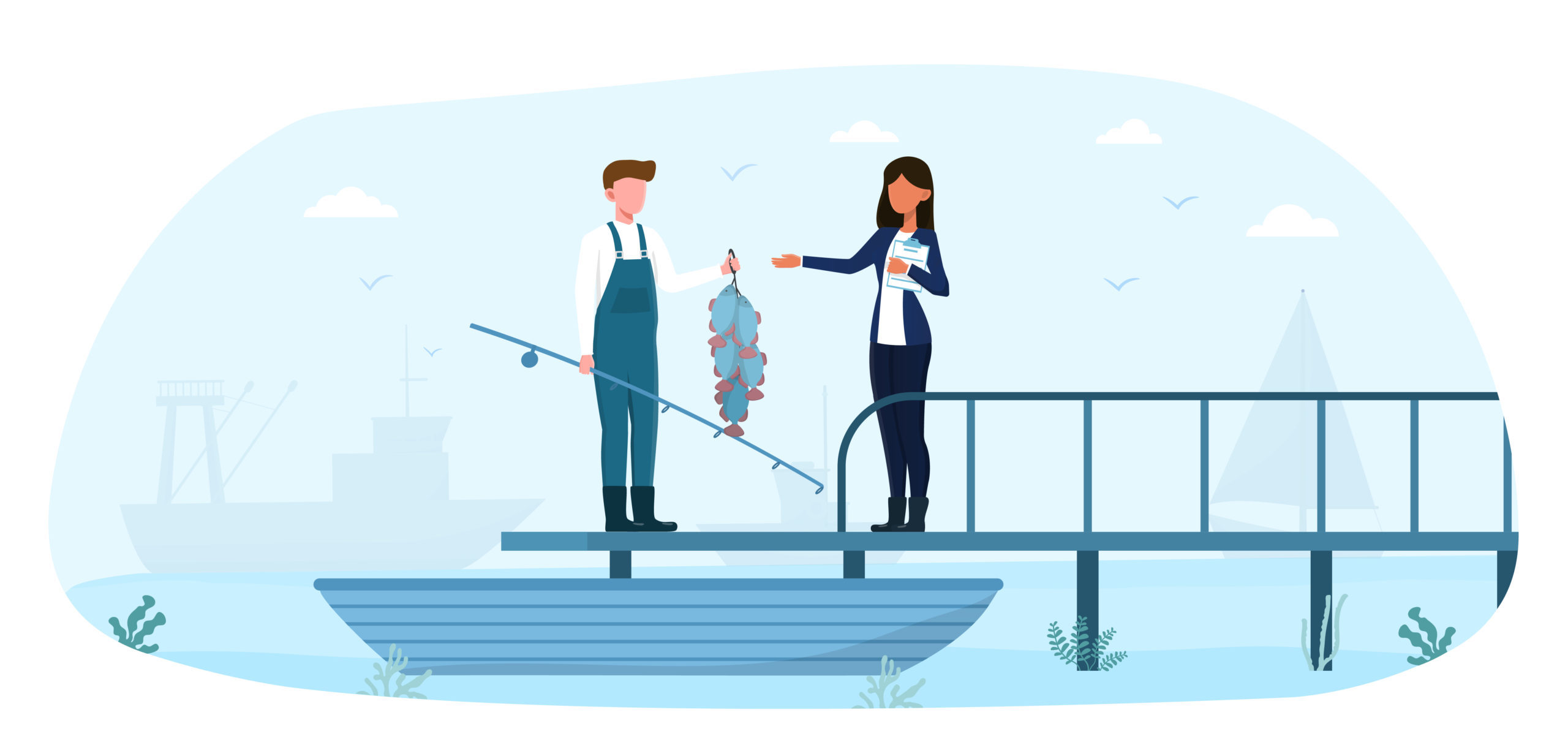Trade Show Marketing Basics 101
When at your trade show booth, you and your staff should be trying to make the most of every lead that walks by. Not every chat is going to create a sale, but every chat could, so even a beginner at trade show design and marketing basics know's that it's vital to make the most of the few minutes you have with every lead.
Marketing at trade shows is a complex, but highly rewarding activity. There are lots of other pieces to getting highly qualified leads from your trade show marketing that we’ve covered in other blog posts, including:
1) Pick the right show (Trade shows are usually focused on specific industries and markets, so pick shows that will have a high percentage of your ideal prospects.)

Illustration of trade show marketing
2) Pick the right booth staff – (It’s a simple truth: if you want to attract the right people to your trade show booth, you have to have the right people in your exhibit stand.)
3) Train your booth staff (Nothing is worse than a staffer that can’t answer simple questions about your company or product – it takes a lot to offset the negative impact of that kind of performance.)
4) Market to your ideal prospects before and during the show (Today’s market is a very social one!)
5) Select trade show booth designs and graphics that will catch the attention of your ideal prospects – our Seattle/Pacific NW based trade show display experts would be happy to help!
With all that said, in today’s blog post, we’re going to focus on client interaction in the trade show booth.
I’d argue that there’s only one question you truly need to answer with any visitor to make them a strong lead, but it’s one that often defies a straight answer: “What do you want?”
You don’t want to ask it so flatly, but ultimately, every sale is need-driven. If a visitor to your trade show display has any interest at all in your products and services, they’re probably not there for grins. There’s something they want, and they think you might be able to provide it.
The more concretely you or your staff can determine what they actually want, the better your chances of providing it. This sounds obvious, but it’s amazing how easy it is to forget in the chaos of an actual trade show.
Eyes on the Prize: Find Out What Your Visitors WANT
1 – Size Them Up
Before even engaging with a visitor, give them a look-over. Do they look like someone with purchasing power or a starry-eyed intern sent to do product research? Does anything about their clothes suggest aspects of their personality, like a preference for certain sports? How expensive are their hairstyles and shoes?
Doing a bit of “cold reading” is always a good idea before starting a sales chat. People tend to respond best to a salesman who “mirrors” their attitudes and ideas. It creates a sense of simpatico.
An obvious example of this is personal space: a “Type A” personality tends to have an in-your-face, very close-up style of talking. Keeping your distance would seem impersonal.
On the other hand, a more introverted person will hang back and get uncomfortable if you get closer than a foot or two.
The more quickly you or your staff can size up a lead, the better you’ll be able to talk to him or her in a way they’ll find appealing.

2 – Start Fishing
There are a lot of different approaches to opening a conversation. Sometimes they make your life easy and immediately go to (or have eyes on) a product, which is an open invitation to start talking about it.
If they aren’t giving you any particular clues, you can usually take a stab in the dark about what they might be interested in, as long as you’re not pushy about it. “So, you’re looking for new financial solutions?” If they’re receptive at all, their answer will clarify their intentions, at least to a certain extent.
That’s your “in.” You should always be extremely focused on what a visitor says. Don’t simply start pitching. In fact, the more time they spend talking, the better. People remember the things they say more often than the things they hear.
If anything, try to avoid specific product talk or redirect it back towards their needs.
Speaking of which…
3 – What They Want Is NOT What They Need
Does someone buy a car simply because they want a car? Aside from specialty collectors, no. People don’t want a car; they want a way to transport themselves.
The average visitor at a trade show probably has no interest whatsoever in the financial software itself. They don’t read the journals or blogs. However, if their books are in the red, their need is to sort out their finances. The hypothetical financial software is just a means to that end.
So, one reason not to just ask, “What do you want?” directly is that you’ll almost never receive the correct answer. They’re not there for the product itself (usually). They’re there because the product solves a problem or provides a way to leverage an opportunity.
That underlying need is what you should look to understand. Why do they need a product or service?
Well, they often don’t like answering that one either. So….
4 – Talk About the Future
In this indirect quest to find out the buyer’s motivations without expecting them to say them outright, look towards their expectations and future goals is a great way of ferreting the information out.
It’s the “Where do you see yourself in a year?” sort of question. Find out what their longer-term goals are and, specifically, what they’re hoping to accomplish with a product like yours. While not universally true, most of the time, the very first thing out of their mouth will directly indicate their needs.
Press on this point if you have time. Try to really get a detailed description of the outcome they want in a month or a year or five. Virtually every point they mention can be assumed the solution to an extent need. Understand the solution, and you’ll have a good idea of the problem – even if they never explicitly say it.
After all, no one likes saying the words “sales slump.” Why embarrass people unnecessarily?
5 – Make Time
If you’ve still got them at this point, things are going well. If they have a vision of the future your product accommodates, and they’re still happily talking about it. They’re pretty much on the hook. Moreover, taking this time to focus on the visitor and their needs is likely to impress them – especially if the next booth just starts shouting a sales pitch at them.
So, find out what kind of timeline they’re on for the purchase cycle. Time isn’t always mentioned in trade show discussions, but it’s always going to weigh on their minds. If you can get a semi-concrete idea of the time scales involved and offer assurances that you can deliver, things are golden.
The Do's and Don'ts of Trade Show Marketing Basics
If you are involved in the trade show industry, you are well aware of everything that goes into making each event successful. Trade shows are highly effective and can help you earn more qualified leads.
However, to take full advantage, you have to maximize your overall involvement in trade shows. This includes understanding the ins and outs and the do's and don'ts of trade show event marketing.
What to DO
Plan Ahead
What you decide to do before trade shows is just as important as what you choose to do during trade shows. To make the best use of your time, you need to make sure to market your involvement in each trade show you attend. You can do this by leveraging your social media accounts and through other digital marketing means.
You have to let people know ahead of time so you can boost your brand awareness, give you much more of a competitive advantage, and also increase your level of productivity during the event.
Set Appointments
A lot of work goes into planning trade shows, but you also can't neglect the time spent following the trade shows. As an exhibitor, you need to make sure to follow up on all your leads. Your team should run over each lead with you after the event, so you know who needs more information, who is ready to purchase, and who needs a bit of nudging.
What NOT to Do
Never Leave Everything Until the Last Minute
If you fail to plan ahead and leave every detail until the last minute, you will find that you are not as organized and as prepared as you need to be. You may forget to bring along literature trade show event attendees may need, for example.
Remember, you want to attract the most qualified leads possible. That means you need to take the time to train your trade show booth staff, find a way to draw a crowd, and be ready to answer any questions a potential customer may have for you and about your brand.
Fail to Use Giveaways
With so many booths at a trade show event, you need to stand out to attract the best leads. Failing to use a giveaway is one way to lose booth traffic. This gets trade show visitors to your booth where you can speak with them about your brand and where they can pick up promotional items that connect them to your brand.
Being Reactive
If you choose to be reactive rather than proactive to trade show event attendees, you may not get the prospects you expect. Make your booth memorable and compelling, and make sure to use every space of your booth wisely. Use the right brand messaging, designs, and layouts to bring people in.

The Bottom Line: Keep Them Talking
Again, the whole key here is largely to keep your leads talking. And most people love talking about themselves most. So, all this accomplishes several things simultaneously:
The conversation builds rapport and makes the encounter memorable
Leads are impressed when a company doesn’t blindly pitch and listens to them instead
Their imaginations get filled with visions of what they want and their happy future
With a bit of analysis, you get a good look into their company’s realistic needs and expectations
You lay virtually all the groundwork for sales to finish the job on Monday
The whole trick here is that since no one will understand a lead’s needs better than the lead, you let them sell themselves on your solution. Listen to their dream, encourage them to develop it as you talk, and assure them you can make it real.
And then, of course, don’t forget to send them home with a load of literature and free goodies!
You may only have a few minutes with each lead at a trade show, but if you’re smart with your conversational strategies, you can make every minute count. By all means, there’s room for chit-chat and sports talk, but always keep your eyes on the prize and keep fishing for clues to their underlying needs.
Uncover their needs and get more qualified leads!
Do you need help making your exhibit look its best? If so, we can help. American Image Displays represents all major manufacturers, so we can create an exhibit to fulfill every wish you could have. For more information, call us at (425) 556-9511 or email [email protected].
Trade Show Lead FAQ
Still have questions about your trade show leads and what they want when they visit your booth? Read on to find out more.
How do you generate leads at a trade show?
It all starts with planning and promotion. The more promotion you can do ahead of the event, the better. You also want to find ways to attract your target audience to gain more qualified leads and then use an efficient lead collection system to keep everything organized and ready to go for after the trade show.
How do you handle leads after the trade show?
Always make sure your offers are relevant to the potential customer. Find ways to create a giveaway or give away swag after the event to keep your brand memorable. Use the leads you have gathered to strategically choose a winner and then prioritize all the leads you have while planning your outreach accordingly.
How many leads should I get from a trade show?
If you take the time to promote your booth and you train your booth staff, then each person at your booth can theoretically generate an average of five to six leads each hour. So, during 8 hours, you can realistically generate up to 48 qualified leads.
How do you collect the names at a trade show?
There are several ways you can collect names for your leads at a trade show event. You can use tablets and other devices in your trade show booth, scan badges or business cards, play games, take pictures, and even have contests and giveaways.
How do you boost booth traffic, leads, and sales with trade show event marketing?
In addition to marketing before the event and utilizing social media platforms, you can also create an event hashtag, stream to your target audience, and use your blog to establish your brand's voice. You can also create an event landing page on your website to appeal to different trade show attendees interests. Some may want to view demos while others are simply wanting a comparison of what you and your competitors offer.
